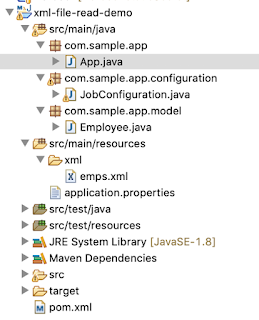In this post, I am going to explain how to read xml data from an xml file.
Input data looks like below.
<employees>
<employee>
<id>1</id>
<firstName>Ram</firstName>
<lastName>Gurram</lastName>
</employee>
<employee>
<id>2</id>
<firstName>Sailaja</firstName>
<lastName>Dokku</lastName>
</employee>
</employees>
Step 1: Define an Employee class that maps employee details.
public class Employee {
private int id;
private String firstName;
private String lastName;
.....
.....
}
Step 2: Define a reader that read the xml data and map to Employee instance.
@Bean
public StaxEventItemReader<Employee> reader() {
StaxEventItemReader<Employee> staxEventItemReader = new StaxEventItemReader<>();
Map<String, Class> aliases = new HashMap<>();
aliases.put("employee", Employee.class);
XStreamMarshaller unMarshaller = new XStreamMarshaller();
unMarshaller.setAliases(aliases);
staxEventItemReader.setResource(new ClassPathResource("/xml/emps.xml"));
staxEventItemReader.setFragmentRootElementName("employee");
staxEventItemReader.setUnmarshaller(unMarshaller);
return staxEventItemReader;
}
Find the below working application.
Step 1: Create new maven project ‘xml-file-read-demo’.
Step 2: Update pom.xml with maven dependencies.
pom.xml
<project xmlns="http://maven.apache.org/POM/4.0.0"
xmlns:xsi="http://www.w3.org/2001/XMLSchema-instance"
xsi:schemaLocation="http://maven.apache.org/POM/4.0.0 http://maven.apache.org/xsd/maven-4.0.0.xsd">
<modelVersion>4.0.0</modelVersion>
<groupId>com.sample.app</groupId>
<artifactId>xml-file-read-demo</artifactId>
<version>1</version>
<parent>
<groupId>org.springframework.boot</groupId>
<artifactId>spring-boot-starter-parent</artifactId>
<version>2.1.6.RELEASE</version>
</parent>
<properties>
<project.build.sourceEncoding>UTF-8</project.build.sourceEncoding>
</properties>
<dependencies>
<!-- https://mvnrepository.com/artifact/org.springframework.batch/spring-batch-core -->
<dependency>
<groupId>org.springframework.batch</groupId>
<artifactId>spring-batch-core</artifactId>
</dependency>
<dependency>
<groupId>org.springframework.boot</groupId>
<artifactId>spring-boot-starter-web</artifactId>
</dependency>
<dependency>
<groupId>org.springframework.boot</groupId>
<artifactId>spring-boot-starter-data-jpa</artifactId>
</dependency>
<dependency>
<groupId>com.h2database</groupId>
<artifactId>h2</artifactId>
</dependency>
<dependency>
<groupId>com.thoughtworks.xstream</groupId>
<artifactId>xstream</artifactId>
<version>1.4.11.1</version>
</dependency>
<!-- https://mvnrepository.com/artifact/org.springframework/spring-oxm -->
<dependency>
<groupId>org.springframework</groupId>
<artifactId>spring-oxm</artifactId>
</dependency>
</dependencies>
</project>
Step 3: Define ‘emps.xml’ file in src/main/resources/xml folder.
emps.xml
<employees>
<employee>
<id>1</id>
<firstName>Ram</firstName>
<lastName>Gurram</lastName>
</employee>
<employee>
<id>2</id>
<firstName>Sailaja</firstName>
<lastName>Dokku</lastName>
</employee>
<employee>
<id>3</id>
<firstName>Harika</firstName>
<lastName>Raghuram</lastName>
</employee>
<employee>
<id>4</id>
<firstName>Gopi</firstName>
<lastName>Battu</lastName>
</employee>
<employee>
<id>5</id>
<firstName>Siva</firstName>
<lastName>Prathipati</lastName>
</employee>
<employee>
<id>6</id>
<firstName>Sharief</firstName>
<lastName>Khan</lastName>
</employee>
<employee>
<id>7</id>
<firstName>Joel</firstName>
<lastName>Chelli</lastName>
</employee>
</employees>
Step 4: Create application.properties file under src/main/resources folder.
application.properties
logging.level.root=ERROR logging.level.org.hibernate=ERROR ## H2 specific properties spring.h2.console.enabled=true spring.h2.console.path=/h2 spring.datasource.url=jdbc:h2:file:~/db/myOrg.db;DB_CLOSE_ON_EXIT=FALSE;DB_CLOSE_DELAY=-1; spring.datasource.username=krishna spring.datasource.password=password123 spring.datasource.driverClassName=org.h2.Driver ## JPA specific properties # Creates the schema, destroying previous data. spring.jpa.hibernate.ddl-auto=create-drop spring.jpa.database-platform=org.hibernate.dialect.H2Dialect spring.jpa.show-sql=false spring.jpa.properties.hibernate.format_sql=false ## Database connection pooling properties # Number of ms to wait before throwing an exception if no connection is available. spring.datasource.max-wait=10000 # Maximum number of active connections that can be allocated from this pool at the same time. spring.datasource.tomcat.max-active=10 spring.datasource.tomcat.max-idle=5 spring.datasource.tomcat.min-idle=3
Step 5: Create a package ‘com.sample.app.model’ and define Employee class.
Employee.java
package com.sample.app.model;
public class Employee {
private int id;
private String firstName;
private String lastName;
public int getId() {
return id;
}
public void setId(int id) {
this.id = id;
}
public String getFirstName() {
return firstName;
}
public void setFirstName(String firstName) {
this.firstName = firstName;
}
public String getLastName() {
return lastName;
}
public void setLastName(String lastName) {
this.lastName = lastName;
}
@Override
public String toString() {
StringBuilder builder = new StringBuilder();
builder.append("Employee [id=");
builder.append(id);
builder.append(", firstName=");
builder.append(firstName);
builder.append(", lastName=");
builder.append(lastName);
builder.append("]");
return builder.toString();
}
}
Step 6: Create a package ‘com.sample.app.configuration’ and define JobConfiguration.
JobConfiguration.java
package com.sample.app.configuration;
import java.util.HashMap;
import java.util.Map;
import org.springframework.batch.core.Job;
import org.springframework.batch.core.Step;
import org.springframework.batch.core.configuration.annotation.EnableBatchProcessing;
import org.springframework.batch.core.configuration.annotation.JobBuilderFactory;
import org.springframework.batch.core.configuration.annotation.StepBuilderFactory;
import org.springframework.batch.core.repository.JobRepository;
import org.springframework.batch.item.xml.StaxEventItemReader;
import org.springframework.beans.factory.annotation.Autowired;
import org.springframework.context.annotation.Bean;
import org.springframework.context.annotation.Configuration;
import org.springframework.core.io.ClassPathResource;
import org.springframework.oxm.xstream.XStreamMarshaller;
import org.springframework.transaction.PlatformTransactionManager;
import com.sample.app.model.Employee;
@Configuration
@EnableBatchProcessing
public class JobConfiguration {
@Autowired
private JobBuilderFactory jobBuilderFactory;
@Autowired
private StepBuilderFactory stepBuilderFactory;
@Bean
public StaxEventItemReader<Employee> reader() {
StaxEventItemReader<Employee> staxEventItemReader = new StaxEventItemReader<>();
Map<String, Class> aliases = new HashMap<>();
aliases.put("employee", Employee.class);
XStreamMarshaller unMarshaller = new XStreamMarshaller();
unMarshaller.setAliases(aliases);
staxEventItemReader.setResource(new ClassPathResource("/xml/emps.xml"));
staxEventItemReader.setFragmentRootElementName("employee");
staxEventItemReader.setUnmarshaller(unMarshaller);
return staxEventItemReader;
}
@Bean
public Step step1() {
return this.stepBuilderFactory.get("step1").chunk(5).reader(reader()).writer(emps -> {
for (Object emp : emps) {
System.out.println(emp);
}
}).build();
}
@Bean
public Job myJob(JobRepository jobRepository, PlatformTransactionManager platformTransactionManager) {
return jobBuilderFactory.get("My-First-Job").start(step1()).build();
}
}
Step 7: Define App.java
App.java
package com.sample.app;
import org.springframework.batch.core.configuration.annotation.EnableBatchProcessing;
import org.springframework.boot.SpringApplication;
import org.springframework.boot.autoconfigure.SpringBootApplication;
@EnableBatchProcessing
@SpringBootApplication
public class App {
public static void main(String[] args) {
SpringApplication.run(App.class, args);
}
}
Total project structure looks like below.
Run App.java, you will see
below messages in console.
Employee [id=1, firstName=Ram, lastName=Gurram]
Employee [id=2, firstName=Sailaja, lastName=Dokku]
Employee [id=3, firstName=Harika, lastName=Raghuram]
Employee [id=4, firstName=Gopi, lastName=Battu]
Employee [id=5, firstName=Siva, lastName=Prathipati]
Employee [id=6, firstName=Sharief, lastName=Khan]
Employee [id=7, firstName=Joel, lastName=Chelli]
You can download complete working application from this link.
https://github.com/harikrishna553/springboot/tree/master/batch/xml-file-read-demo

No comments:
Post a Comment